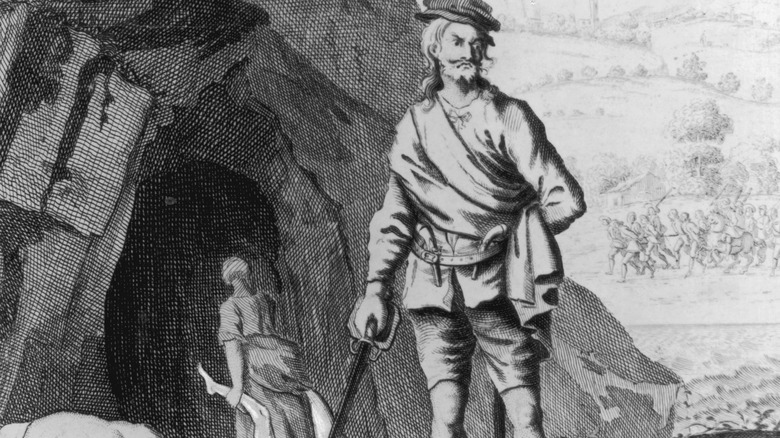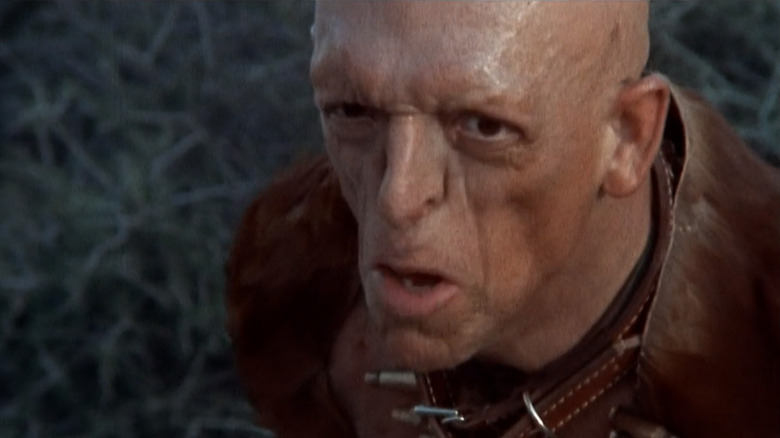The Terrifying Real-Life Origin Story Behind The Hills Have Eyes
Even if none of his subsequent films were ever made, Wes Craven's 1977 film "The Hills Have Eyes" would still be enough to make him a well-respected name in horror circles. Though only his second film, it already bore many of the hallmarks that would make him a master of the genre: frank depictions of brutal violence, a distinct dash of social satire, and a wry view of America's darker sides.
"The Hills Have Eyes" also solidifies Craven as a horror auteur with a penchant for unique source material. The inspiration for "A Nightmare on Elm Street" is by now fairly well-known among horror fans. As Craven told Vulture in their oral history of the classic film, he got the idea from a story in the Los Angeles Times of a young boy –- son of refugees from the Cambodian killing fields –- whose nightmares became so extreme that he died in his sleep.
For the inspiration behind "The Hills Have Eyes," the story of a suburban family set upon by a family of rural cannibals, Craven went back a great deal further. But the story he came across was no less macabre or chilling.
The Hills Have Eyes is based on the legend of Sawney Bean
As recounted in Thommy Hutson's book Never Sleep Again, Craven came across the inspiration for "The Hills Have Eyes" when he encountered the Scottish legend of Sawney Bean at the New York Public Library while doing research. As goes the legend, Alexander "Sawney" Bean was born in the East Lothian region of Scotland sometime in the 16th century. A disturbed and violent young man, he was lucky enough to find a wife who shared his disturbing predilections: a woman named "Black Agnes" Douglas. Unwilling to conform to the world around them or deny their base craving for human flesh, the two retreated to a cave in the countryside, where they had several children and, through incestuous relationships, a few dozen grandchildren. In total, the cave-dwelling clan was said to have been almost fifty-strong.
The story goes that the Bean clan survived by ambushing, killing, and then eating travelers and various passersby. Most often, victims were dismembered in the cave, and, after they were done eating, the Beans would pickle what was left over in barrels. Over the course of around 25 years, they were said to have killed and eaten over a thousand people.
Vicious and civilized
The clan was only stopped when the Scottish King James VI was alerted of them; the king then allegedly assembled a team of 400 men to hunt down the Sawney Bean family. The entire family was then executed (via BBC.com). Though the story features prominently in Scottish legend, there is, thankfully, no proof that the Sawney Bean clan ever actually existed.
What seems to have fascinated Wes Craven the most about the story though wasn't just the sheer brutality of the Bean family's actions, but the brutality of their executions. According to some versions of the story, the men of the Bean family were mutilated and left to bleed to death in front of the women and children, who were then burned alive themselves (via The Scotsman).
"And I was so struck by how on the one hand you have this feral family that's killing people and eating them," Craven said in a 1977 interview with Arrow magazine (via Unilad). "But if you look at it they weren't doing anything that much worse than civilization did when they caught them. And I just thought what a great kind of A/B of culture. How the most civilized can be the most savage and how the most savage can be civilized." It was this that gave Craven the idea of one of the signatures of "The Hills Have Eyes," that is that the surviving members of the supposedly civilized suburban Carter and Wood families end up resorting to the same viciousness as the hill folk who have attacked them.


